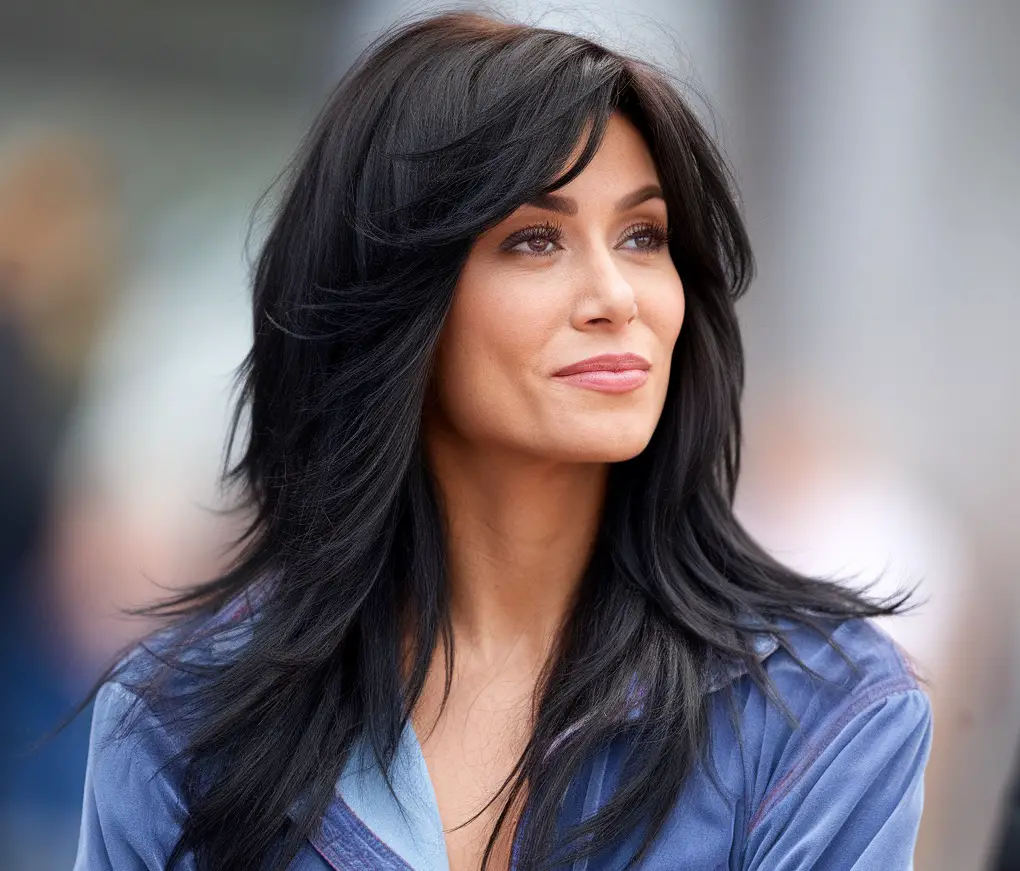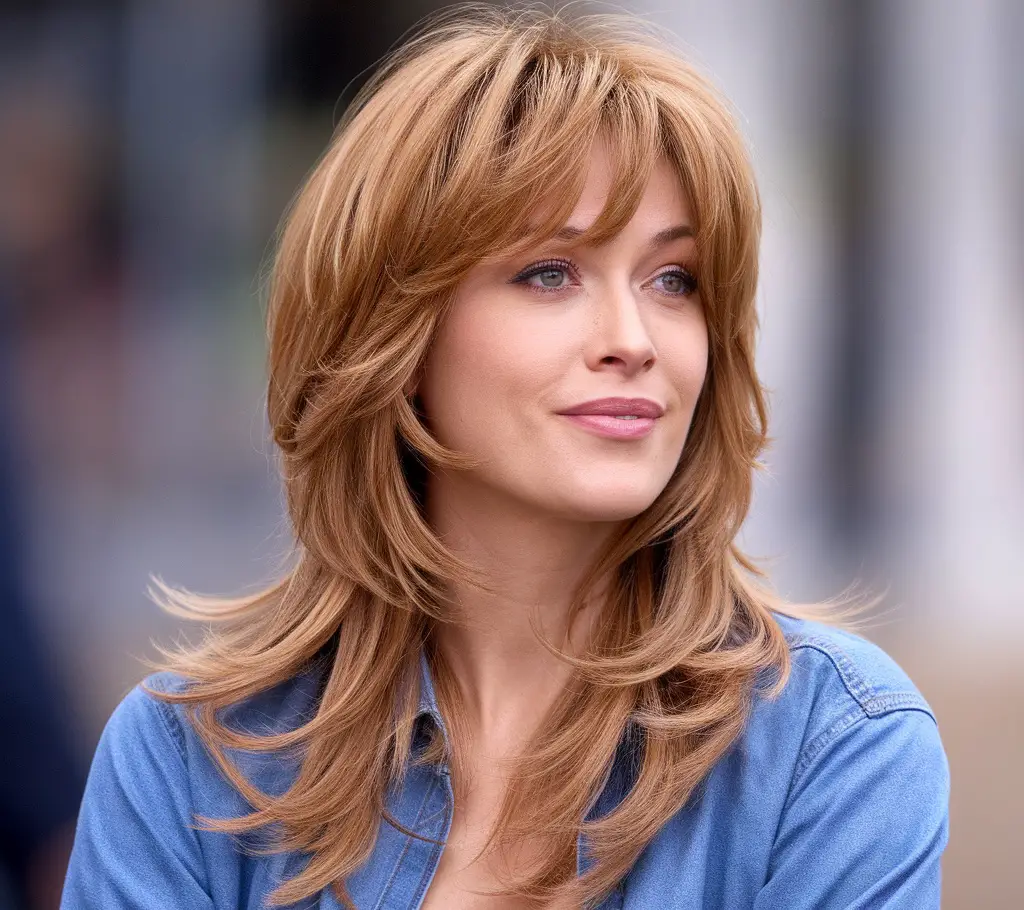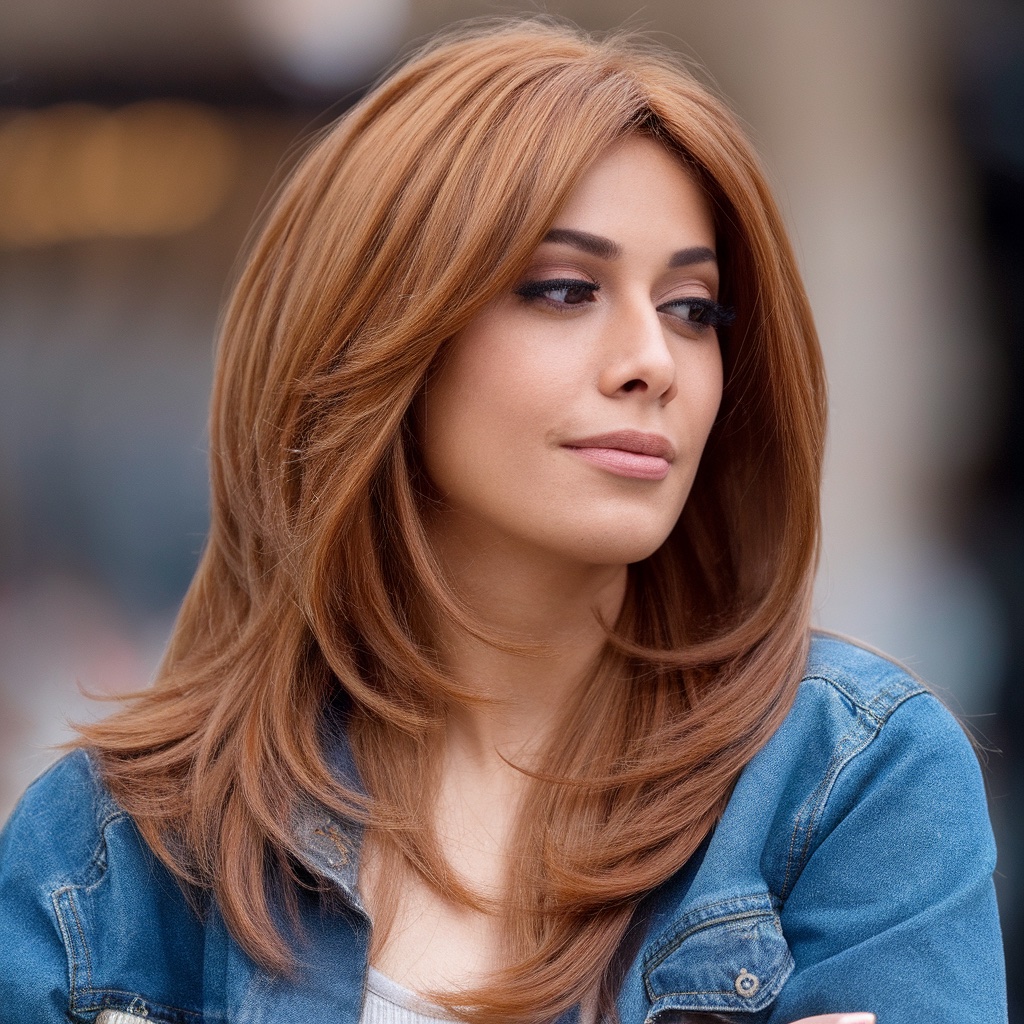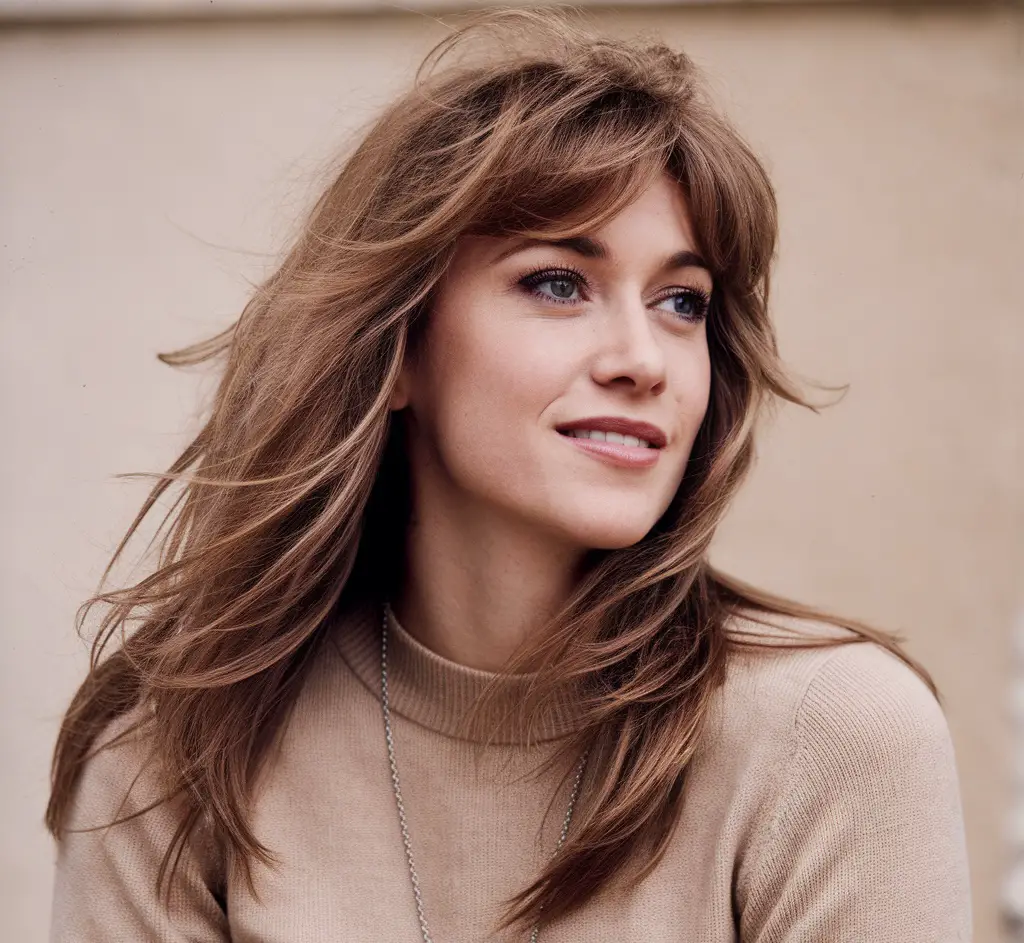Long hair offers a canvas for creativity, and layered haircuts are a fantastic way to add dimension and style. These cuts involve trimming hair at different lengths, creating a cascading effect that can transform your look. Layered haircuts for long hair have become increasingly popular among women seeking to refresh their appearance without sacrificing length.
The appeal of layered cuts lies in their versatility and ability to flatter various face shapes and hair textures. By removing weight from the right places, layers can add volume, movement, and a sense of lightness to long locks. This technique can breathe new life into flat or lifeless hair, making it appear fuller and more dynamic.
In the following sections, we’ll explore the elements that make layered haircuts stand out on long hair. We’ll discuss how to choose the right layered cut for your hair type and face shape, the benefits of these styles, and tips for maintaining and styling your new look. Whether you’re looking for a subtle change or a bold transformation, layered haircuts offer exciting possibilities for your long hair.
- What makes a layered haircut stand out on long hair?
- Which layered haircuts work best for long hair?
- How do you choose the right layered cut for your long hair?
- What are the benefits of layered haircuts for long hair?
- How can you style layered long hair?
- How do you maintain layered long hair?
- Elevate Your Look with Layered Long Hair
- Frequently Asked Questions
What makes a layered haircut stand out on long hair?

Layered haircuts for long hair can transform your look, adding depth and dimension to your locks. But what sets apart a truly outstanding layered cut? Let’s explore the key elements that make these styles shine.
Face-framing layers
Face-framing layers are a game-changer for long hair. These shorter pieces around your face can soften your features and highlight your best attributes. By strategically placing layers near your cheekbones or jawline, you can create a flattering frame that draws attention to your eyes and smile.
How do face-framing layers work? They’re cut shorter than the rest of your hair, gradually blending into the longer lengths. This technique can be adjusted to suit different face shapes:
- For round faces: Longer layers starting at the chin
- For oval faces: Layers beginning at the cheekbones
- For square faces: Soft, wispy layers around the jawline
Textured ends
Textured ends are another crucial aspect of a standout layered haircut. They add movement and prevent your long hair from looking heavy or weighed down. Hairstylists use special techniques to create texture, such as point-cutting or razor-cutting the ends of your hair.
These methods remove bulk and create a softer, more natural-looking finish. Textured ends can make your hair appear thicker and more voluminous, especially when styled with waves or curls.
Varied layer lengths
A mix of different layer lengths is what gives a layered haircut its distinctive look. Short layers add volume to the crown, while longer layers maintain the overall length and create a flowing effect. This variation in length creates depth and dimension, making your hair look fuller and more dynamic.
Think of your hair as a cascading waterfall, with each layer contributing to the overall movement and flow. The key is to blend these layers seamlessly, creating a cohesive look that doesn’t appear choppy or disconnected.
Strategic placement
The placement of layers can make or break a haircut. A skilled stylist will consider your hair type, face shape, and personal style when deciding where to place layers. For example:
- Layers placed near the crown can add volume for those with fine hair
- Layers starting at the chin can elongate round faces
- Layers throughout the length can reduce bulk in thick hair
Strategic placement is about creating balance and harmony in your haircut. It’s not just about where the layers start, but how they flow and interact with each other.
Customized techniques
Every head of hair is unique, which is why customized cutting techniques are essential for a standout layered haircut. Your stylist might use a combination of methods to achieve the perfect look for you:
Below are some popular techniques:
- Slide cutting for a soft, blended effect
- Point cutting for added texture
- Razor cutting for wispy, feathered ends
- Dry cutting for precision shaping
These techniques allow for a personalized approach, taking into account your hair’s natural texture, density, and growth patterns.
A truly outstanding layered haircut for long hair combines all these elements in a way that complements your individual features and style. It’s not just about following trends, but creating a look that enhances your natural beauty and fits your lifestyle.
Remember, communication with your stylist is key. Bring reference photos and be clear about your preferences and concerns. A great layered haircut should make you feel confident and beautiful, with hair that moves and flows naturally.
Which layered haircuts work best for long hair?

Long hair offers a wide range of styling possibilities, and layered cuts can add depth and dimension to your locks. Let’s explore some of the most flattering layered haircuts for long hair that will make you stand out.
Long shag with wispy bangs
The long shag is a modern take on a classic style. It combines choppy layers throughout the hair with wispy bangs to create a relaxed, effortless look. This cut works well for various hair textures, from straight to wavy.
What makes the long shag so appealing? It’s the perfect balance between edgy and soft. The layers add volume and movement, while the wispy bangs frame your face beautifully. This style is particularly great if you want to add some rock ‘n’ roll flair to your long locks.
To style a long shag, you have several options:
- Air-dry with a texturizing spray for a beachy look
- Use a round brush while blow-drying for more volume
- Create loose waves with a curling iron for a bohemian vibe
Cascading waterfall layers
Cascading waterfall layers are a stunning option for those who want to maintain their length while adding movement and dimension. This cut features long layers that gradually get shorter towards the front, creating a beautiful cascading effect.
The beauty of this style lies in its versatility. It works well with various hair types and face shapes, adding softness and movement to your overall look. The layers are strategically placed to enhance your facial features and create a flattering silhouette.
One of the best things about cascading waterfall layers is how they catch the light, creating a multi-dimensional effect that makes your hair look fuller and more vibrant.
V-cut with long layers
The V-cut is a classic choice for long hair that never goes out of style. This cut creates a V-shape at the back of your hair, with the longest point in the middle and shorter layers on the sides. It’s an excellent option if you want to add shape to your hair without losing length.
Why choose a V-cut? It offers several benefits:
- Adds movement and dimension to long hair
- Creates the illusion of thicker hair
- Works well with both straight and wavy textures
- Easy to maintain and style
To enhance the V-shape, consider adding some long layers throughout your hair. This will create even more movement and prevent your hair from looking heavy or weighed down.
Feathered layers throughout
Feathered layers are a fantastic way to add texture and volume to long hair. This technique involves cutting the ends of your hair at an angle, creating a soft, feathered effect. When applied throughout your hair, it results in a light, airy look that moves beautifully.
Feathered layers work particularly well for fine or thin hair, as they can create the illusion of fuller, more voluminous locks. They’re also great for thick hair, as they can remove bulk and add movement.
To style feathered layers, try using a round brush while blow-drying to enhance the feathered effect. You can also use a flat iron to create soft bends in your hair, emphasizing the layers.
Curtain bangs with long layers
Curtain bangs have become increasingly popular, and for good reason. When paired with long layers, they create a soft, romantic look that flatters many face shapes. Curtain bangs are parted in the middle and sweep to the sides, framing your face beautifully.
The combination of curtain bangs and long layers offers several advantages:
- Softens strong jawlines or angular features
- Draws attention to your eyes and cheekbones
- Adds a touch of retro charm to your look
- Grows out gracefully, blending into your layers
To style curtain bangs, use a round brush to blow-dry them away from your face. You can also use a flat iron to create a slight bend at the ends for a more polished look.
Each of these layered haircuts offers a unique way to enhance your long hair. The key is to choose a style that complements your face shape, hair texture, and personal style. Don’t be afraid to mix and match elements from different cuts to create a look that’s truly your own. With the right layered haircut, you’ll have long, luscious locks that turn heads wherever you go.
How do you choose the right layered cut for your long hair?

Selecting the perfect layered cut for your long hair can be an exciting journey. The right style can enhance your features, boost your confidence, and make hair management a breeze. Let’s explore how to choose a layered cut that suits you best.
Consider your face shape
Your face shape plays a crucial role in determining which layered cut will flatter you most. Different layer placements can accentuate or soften certain facial features.
For oval faces, you’re in luck! Most layered styles work well. Try long layers starting at the cheekbones to highlight your balanced proportions.
Round faces benefit from layers that begin below the chin. This creates the illusion of length and helps slim the face.
If you have a square face, soft, wispy layers around the jawline can soften angular features.
Heart-shaped faces look great with side-swept bangs and layers that start at the chin, balancing out a wider forehead.
Think about your hair texture
Your hair’s natural texture is another key factor in choosing the right layered cut. Different textures respond differently to layering techniques.
Fine hair often looks best with fewer, strategically placed layers. Too many layers can make fine hair appear thinner. Consider long layers that start mid-length to create the illusion of volume.
For thick hair, layers can help remove bulk and add movement. You might enjoy a cut with layers throughout to reduce weight and add bounce.
Curly hair benefits from layers that enhance your natural curl pattern. Dry cutting techniques often work well for curly textures, allowing the stylist to see how your curls fall naturally.
Factor in your lifestyle
Your daily routine and styling preferences should guide your choice of layered cut. Ask yourself:
- How much time can you dedicate to styling your hair each day?
- Do you prefer low-maintenance styles or enjoy experimenting with different looks?
- What’s your typical hair care routine?
A busy lifestyle might call for a more low-maintenance cut with fewer layers, while those who enjoy styling their hair might opt for more intricate layering.
Consult with a stylist
A professional stylist can offer valuable insights based on their expertise and experience. During your consultation, discuss:
- Your hair goals
- Any concerns you have about your current style
- Your willingness to use styling products or tools
Be open about your expectations and listen to their suggestions. They might recommend techniques or variations you hadn’t considered.
Look at reference photos
Visual aids can be incredibly helpful when communicating your desired look to your stylist. Collect images of layered cuts you like, but keep in mind:
- The same cut might look different on various hair types and face shapes
- Lighting and styling in photos can affect how a cut appears
- Some images might be digitally altered
Use these photos as inspiration rather than exact templates. Your stylist can help you understand which elements of these cuts might work for you.
Now, let’s recap some key points to remember when choosing your layered cut:
- Match the layer placement to your face shape
- Consider your hair’s natural texture and density
- Think about your daily styling routine and preferences
- Seek professional advice from a trusted stylist
- Use inspiration photos as a starting point for discussion
By taking these factors into account, you’ll be well on your way to finding a layered cut that not only looks fantastic but also suits your individual needs and lifestyle. The perfect layered cut for your long hair is out there, waiting to bring out your best features and make you feel confident every day.
What are the benefits of layered haircuts for long hair?

Long hair can be a beautiful asset, but sometimes it needs a little extra oomph to truly shine. This is where layered haircuts come into play. They offer numerous advantages that can transform your long locks from flat to fabulous.
Adds volume and movement
One of the most significant benefits of layered cuts is their ability to inject life into your hair. By removing weight from strategic areas, layers create the illusion of fuller, more voluminous hair. This is especially beneficial for those with fine or thin hair.
But how exactly do layers add volume? The answer lies in the way they’re cut. Shorter pieces of hair naturally lift away from the scalp, creating a fuller appearance. This effect is particularly noticeable when you move your head, as the layers allow for more dynamic movement.
Have you ever noticed how some women’s hair seems to flow effortlessly, even in a light breeze? That’s the magic of well-placed layers at work.
Reduces bulk and weight
For those blessed (or sometimes cursed) with thick, heavy hair, layers can be a game-changer. By removing excess weight, a layered cut can make your hair more manageable and less prone to falling flat.
Think of it like thinning out a dense forest. By selectively removing some trees, you allow more light and air to circulate, creating a healthier environment. Similarly, layers allow your hair to ‘breathe,’ reducing that weighed-down feeling that can come with very thick, long hair.
This reduction in bulk can also lead to faster drying times and easier styling, which brings us to our next point.
Creates versatile styling options
Layered cuts open up a world of styling possibilities. With layers, you can:
- Create bouncy, voluminous blowouts
- Achieve beachy waves with minimal effort
- Pull off sleek, straight styles without looking flat
- Rock messy, textured updos
- Experiment with half-up, half-down styles
The variety of lengths in a layered cut gives you more to work with, allowing for greater creativity in your daily styling routine.
Frames the face beautifully
A well-executed layered cut can highlight your best features and soften any areas you’d prefer to downplay. Face-framing layers, for instance, can accentuate your cheekbones, draw attention to your eyes, or soften a strong jawline.
Consider this: if your face were a painting, your hair would be the frame. Just as the right frame can enhance a work of art, the right layered cut can enhance your natural beauty.
Different layer lengths can achieve different effects. Shorter layers around the face can create a soft, romantic look, while longer layers can elongate your face shape. Your stylist can customize the layering to complement your unique facial structure.
Enhances natural texture
Do you often find yourself fighting against your hair’s natural texture? Layered cuts can work with your hair’s inherent qualities, not against them.
For curly hair, layers can help define and separate curls, reducing frizz and enhancing your natural curl pattern. If you have wavy hair, layers can bring out those waves, giving you that coveted ‘beach hair’ look with minimal effort.
Even for straight hair, layers can add a touch of natural-looking texture and movement. They can prevent your hair from looking too ‘flat’ or one-dimensional, giving it more depth and interest.
It’s worth noting that the way layers enhance your natural texture can also make your hair easier to style. You might find that you need less time and fewer products to achieve your desired look.
Layered haircuts for long hair offer a multitude of benefits, from adding volume and reducing weight to framing your face and enhancing your natural texture. They provide versatility in styling and can make your hair more manageable on a day-to-day basis.
However, it’s important to remember that not all layered cuts are created equal. The key to reaping these benefits lies in finding a skilled stylist who can tailor the layering technique to your specific hair type, face shape, and lifestyle needs. With the right layered cut, you can enjoy all these advantages while maintaining the length you love.
How can you style layered long hair?

Layered long hair offers a playground of styling possibilities. With the right techniques and tools, you can create a variety of looks that showcase your hair’s natural beauty and movement. Let’s explore some popular styling options that will make your layered locks shine.
Beach waves
Who doesn’t love the effortless, carefree look of beach waves? This style perfectly complements layered long hair, emphasizing the different lengths and adding texture. To achieve this look, you don’t need to visit the beach – just a few simple steps will do.
Start by applying a sea salt spray to damp hair. Scrunch your hair gently and let it air dry, or use a diffuser attachment on your hairdryer for faster results. Once dry, take sections of your hair and wrap them around a curling wand, leaving the ends out for a more natural look. Alternate the direction of the curls for a less uniform appearance. Finally, run your fingers through your hair to break up the curls and create that coveted beachy texture.
Sleek and straight
A sleek, straight style can really showcase the precision of your layered cut. This look is perfect for formal events or when you want to appear polished and professional.
Begin with freshly washed hair and apply a heat protectant product. Blow-dry your hair in sections using a round brush, focusing on creating smoothness and volume at the roots. Once your hair is completely dry, use a flat iron to straighten small sections at a time. Pay special attention to your layers, ensuring they blend seamlessly. Finish with a light-hold hairspray to keep everything in place without sacrificing movement.
Half-up, half-down styles
Half-up, half-down styles are versatile and flattering for layered long hair. They allow you to show off your length while keeping hair out of your face. Here’s a simple yet elegant option to try:
- Part your hair down the middle
- Take two-inch sections from each side of your face
- Twist these sections back and secure with bobby pins
- Repeat with additional sections if desired
- Finish by curling or straightening the loose hair
This style works well with both straight and wavy textures, making it a go-to option for many occasions.
Braided looks
Braids are a fantastic way to highlight the different lengths in your layered cut. From classic three-strand braids to more intricate styles, the options are endless. One popular choice is the French braid crown:
Start by parting your hair down the middle. Begin a French braid on one side of your head, incorporating hair as you go. Continue braiding around the back of your head and up the other side. Secure the end with an elastic. Repeat on the other side, connecting the two braids at the back of your head. Gently pull on the braids to loosen them slightly, creating a softer look.
This style not only looks beautiful but also keeps your hair secure throughout the day.
Messy buns and updos
Layered long hair lends itself beautifully to messy buns and updos. These styles allow you to show off your layers while keeping your hair off your neck – perfect for hot days or casual events.
For a quick and easy messy bun:
- Gather your hair into a high ponytail
- Twist the ponytail and wrap it around its base
- Secure with bobby pins
- Gently pull out a few face-framing pieces
- Loosen the bun slightly for a more relaxed look
The key to a great messy bun is embracing imperfection. Don’t worry about making it too neat – the layers will naturally create an interesting texture.
Styling layered long hair doesn’t have to be complicated. With these techniques in your arsenal, you can create a variety of looks to suit any occasion. Remember, practice makes perfect, so don’t be discouraged if your first attempts don’t turn out exactly as planned.
Experiment with different products and tools to find what works best for your hair type and texture. Some days you might opt for a sleek, straight look, while others call for beachy waves or an intricate braid. The beauty of layered long hair lies in its versatility – so have fun exploring all the styling possibilities!
How do you maintain layered long hair?

Maintaining layered long hair requires a bit of extra care and attention, but the results are well worth the effort. With the right approach, you can keep your locks looking healthy, vibrant, and full of life. Let’s explore some essential maintenance tips that will help you make the most of your layered hairstyle.
Regular trims
One of the most crucial aspects of maintaining layered long hair is scheduling regular trims. But how often should you visit your stylist? The answer might surprise you.
While many believe that frequent trims lead to faster hair growth, this isn’t entirely accurate. Hair grows from the roots, not the ends. However, regular trims are essential for preventing split ends and maintaining the shape of your layers.
Aim for a trim every 8-12 weeks, depending on how quickly your hair grows and how well you maintain it between salon visits. During these appointments, your stylist can refresh your layers, ensuring they continue to frame your face beautifully and move as intended.
Use the right products
Choosing the right hair care products can make a significant difference in the health and appearance of your layered long hair. But with so many options available, how do you know which ones are best for you?
Start by identifying your hair type and any specific concerns you have. Is your hair dry, oily, or somewhere in between? Do you struggle with frizz or lack of volume? Once you’ve pinpointed your needs, look for products that address these issues.
For layered long hair, consider the following:
- A volumizing shampoo to add body to your roots
- A lightweight conditioner that won’t weigh down your layers
- A leave-in conditioner to keep ends hydrated
- A texturizing spray to enhance the movement of your layers
Remember, what works for one person might not work for another. Don’t be afraid to experiment with different products until you find your perfect combination.
Protect from heat damage
Heat styling tools can be a double-edged sword for layered long hair. While they can help you achieve beautiful styles, they can also cause significant damage if not used properly. So, how can you protect your hair while still enjoying the versatility of heat styling?
First and foremost, always use a heat protectant product before applying any heat to your hair. These products create a barrier between your hair and the heat, reducing the risk of damage.
Set your tools to the lowest effective temperature. Fine or damaged hair might only need 300°F, while thicker or coarser hair might require up to 380°F. Avoid going above 400°F, as this can cause severe damage to your hair.
Consider investing in high-quality heat styling tools with ceramic or tourmaline plates. These materials distribute heat more evenly, reducing the risk of hot spots that can damage your hair.
Avoid over-washing
How often do you wash your hair? If you’re lathering up every day, you might be doing more harm than good, especially for layered long hair.
Over-washing can strip your hair of its natural oils, leading to dryness, frizz, and even breakage. For most people with layered long hair, washing 2-3 times a week is sufficient.
On non-wash days, you can refresh your hair with dry shampoo. This product absorbs excess oil at the roots, helping your hair look and feel cleaner between washes. Apply it to your roots, wait a few minutes, then brush it through your hair.
If you have very oily hair and feel you need to wash more frequently, try using a gentle, sulfate-free shampoo to avoid over-drying your locks.
Nourish with hair masks
Hair masks are like a spa treatment for your layered long hair. They provide deep conditioning and nourishment, helping to keep your locks soft, shiny, and healthy. But how often should you use a hair mask, and what kind should you choose?
For most hair types, using a hair mask once a week is ideal. If your hair is particularly dry or damaged, you might benefit from using one twice a week. Choose a mask that suits your hair type and concerns. For example:
- Protein masks for strengthening weak or damaged hair
- Moisturizing masks for dry or frizzy hair
- Clarifying masks for oily hair or product buildup
Apply the mask to damp hair, focusing on the mid-lengths and ends where layered hair tends to be drier. Leave it on for the recommended time (usually 5-30 minutes), then rinse thoroughly.
By incorporating these maintenance tips into your hair care routine, you can keep your layered long hair looking its best. Remember, everyone’s hair is different, so it may take some trial and error to find the perfect routine for you. Be patient with your hair, and don’t hesitate to ask your stylist for personalized advice on maintaining your specific cut and style.
Elevate Your Look with Layered Long Hair
Layered long hair offers a world of possibilities for women seeking to refresh their style without sacrificing length. From adding volume and movement to creating versatile styling options, this cut can truly transform your look. By choosing the right layered style for your face shape and hair texture, you can enhance your natural beauty and boost your confidence.
Maintaining your layered long hair doesn’t have to be a complex task. With regular trims, the right products, and proper care techniques, you can keep your locks looking healthy and vibrant. Whether you prefer beachy waves, sleek straight styles, or intricate updos, your layered long hair provides the perfect canvas for expressing your personal style. So go ahead, experiment with different looks, and enjoy the beauty and versatility of your layered long hair.
Frequently Asked Questions
Q: What are the main benefits of layered haircuts for long hair?
A: Layered haircuts add volume and movement, reduce bulk and weight, frame the face beautifully, create versatile styling options, and enhance natural texture.
Q: How often should I trim my layered long hair?
A: Aim for a trim every 8-12 weeks to maintain the shape of your layers and prevent split ends.
Q: What types of products work best for layered long hair?
A: Consider using a volumizing shampoo, lightweight conditioner, leave-in conditioner, and texturizing spray to enhance your layers and maintain hair health.
Q: How can I protect my layered long hair from heat damage?
A: Always use a heat protectant product, set styling tools to the lowest effective temperature, and invest in high-quality tools with ceramic or tourmaline plates.
Q: How often should I wash my layered long hair?
A: For most people, washing 2-3 times a week is sufficient. Use dry shampoo between washes to refresh your hair.
Q: What are some popular styling options for layered long hair?
A: Popular styles include beach waves, sleek and straight looks, half-up half-down styles, braided looks, and messy buns or updos.
Q: How do I choose the right layered haircut for my face shape?
A: Consider your face shape and consult with a stylist. For example, long layers starting at the chin can elongate round faces, while soft layers around the jawline can soften square faces.
Q: How often should I use a hair mask on my layered long hair?
A: For most hair types, using a hair mask once a week is ideal. If your hair is particularly dry or damaged, you might benefit from using one twice a week.

